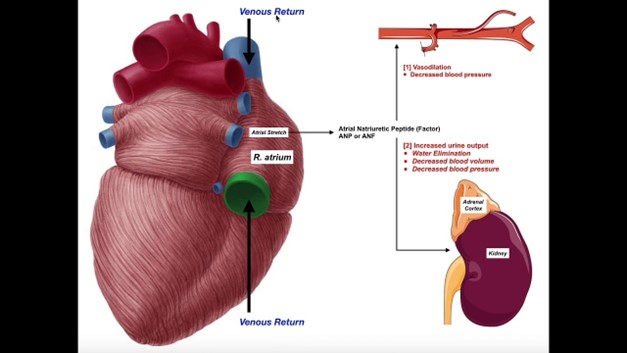In an ECG pattern, the P wave is caused by:
Repolarization of atrial muscle fibers.
Depolarization of atrial muscle fibers.
Depolarization of ventricular muscle fibers.
Repolarization of ventricular muscle fibers.
The Correct Answer is B
This means that the electrical activity that causes the atria to contract starts from the sinoatrial node and spreads across the atria.
The P wave on the ECG reflects this atrial depolarization.
Choice A is wrong because repolarization of atrial muscle fibers is not visible on the ECG, as it occurs during the QRS complex when the ventricular depolarization masks it.
Choice C is wrong because the depolarization of ventricular muscle fibers is represented by the QRS complex on the ECG, not the P wave.
Choice D is wrong because the repolarization of ventricular muscle fibers is represented by the T wave on the ECG, not the P wave.
Normal ranges for the P wave are:
Duration: less than 0.12 seconds (less than 3 small squares)
Amplitude: less than 2.5 mm (0.25 mV) in the limb leads, less than 1.5 mm (0.15 mV) in the precordial leads
Axis: between 0° and +75°12
Nursing Test Bank
Naxlex Comprehensive Predictor Exams
Related Questions
Correct Answer is D
Explanation
Atrial natriuretic peptide (ANP) is a hormone secreted by the heart when the atria are stretched by high blood pressure or volume.

ANP has multiple effects, such as increasing urine and salt excretion, lowering blood pressure, and opposing the renin-angiotensin-aldosterone system.
Therefore, ANP inhibits the release of renin and aldosterone, which are hormones that increase blood pressure and sodium retention.
Choice A is wrong because ANP is not released from the adrenal cortex but from the cardiac atria.
ANP does not stimulate atrial hormones but rather inhibits them.
Choice B is wrong because ANP is not stimulated to release when blood volume decreases, but when it increases.
ANP acts to reduce blood volume by promoting diuresis and natriuresis.
Choice C is wrong because ANP does not raise blood pressure, but lowers it. ANP acts as a vasodilator and reduces peripheral resistance.
Correct Answer is A
Explanation
The correct answer is choice A. True.
Blood flow through a capillary is controlled by a precapillary sphincter, which opens or closes due to the requirements of the cells supplied by the capillary.
This allows blood to bypass the capillaries when they are not needed and to increase blood flow when they are needed.
Choice B. False is wrong because it contradicts the true statement in choice A. A precapillary sphincter is a ring of smooth muscle that surrounds the entrance of a capillary and regulates blood flow into it.
It is influenced by local factors such as oxygen, carbon dioxide, pH, and temperature.
Whether you are a student looking to ace your exams or a practicing nurse seeking to enhance your expertise , our nursing education contents will empower you with the confidence and competence to make a difference in the lives of patients and become a respected leader in the healthcare field.
Visit Naxlex, invest in your future and unlock endless possibilities with our unparalleled nursing education contents today
Report Wrong Answer on the Current Question
Do you disagree with the answer? If yes, what is your expected answer? Explain.
Kindly be descriptive with the issue you are facing.
